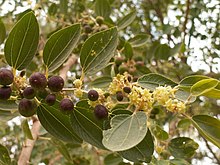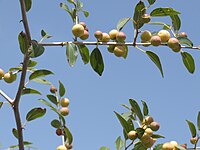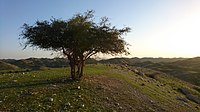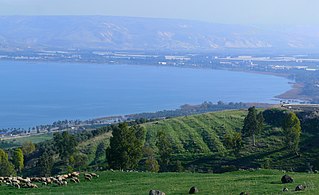
The Sea of Galilee, also called Lake Tiberias or Kinneret, is a freshwater lake in Israel. It is the lowest freshwater lake on Earth and the second-lowest lake in the world, at levels between 215 metres (705 ft) and 209 metres (686 ft) below sea level. It is approximately 53 km (33 mi) in circumference, about 21 km (13 mi) long, and 13 km (8.1 mi) wide. Its area is 166.7 km2 (64.4 sq mi) at its fullest, and its maximum depth is approximately 43 metres (141 ft). The lake is fed partly by underground springs, but its main source is the Jordan River, which flows through it from north to south and exits the lake at the Degania Dam.

Jujube, sometimes jujuba, known by the scientific name Ziziphus jujuba and also called red date, Chinese date, and Chinese jujube, is a species in the genus Ziziphus in the buckthorn family Rhamnaceae.

The Rhamnaceae are a large family of flowering plants, mostly trees, shrubs, and some vines, commonly called the buckthorn family. Rhamnaceae is included in the order Rosales.

Ziziphus is a genus of about 40 species of spiny shrubs and small trees in the buckthorn family, Rhamnaceae, distributed in the warm-temperate, subtropical and tropical regions of the world. The leaves are alternate, entire, with three prominent basal veins, and 2–7 cm (0.79–2.76 in) long; some species are deciduous, others evergreen. The flowers are small, inconspicuous yellow-green. The fruit is an edible drupe, yellow-brown, red, or black, globose or oblong, 1–5 cm (0.39–1.97 in) long, often very sweet and sugary, reminiscent of a date in texture and flavour.

According to the New Testament, a woven crown of thorns was placed on the head of Jesus during the events leading up to his crucifixion. It was one of the instruments of the Passion, employed by Jesus' captors both to cause him pain and to mock his claim of authority. It is mentioned in the gospels of Matthew, Mark and John, and is often alluded to by the early Church Fathers, such as Clement of Alexandria, Origen and others, along with being referenced in the apocryphal Gospel of Peter.

Kinneret is the name of an important Bronze and Iron Age city situated on the northwestern shore of the Sea of Galilee, mentioned in the 14th century BC Aqhat Epic of Ugarit, and in the Old Testament and New Testament. Older Bible translations spell the name alternatively Kinnereth or Chinnereth, and sometimes in the plural as Chinneroth. In time the name became Gennesaret and Ginosar. The remains of Kinneret have been excavated at a site called Tell el-'Oreimeh in Arabic and Tel Kinrot in Modern Hebrew.

Ziziphus mauritiana, also known as Indian jujube, Indian plum, Chinese date, Chinee apple, ber and dunks is a tropical fruit tree species belonging to the family Rhamnaceae. It is often confused with the closely related Chinese jujube, but whereas Z. jujuba prefers temperate climates, Z. mauritiana is tropical to subtropical.
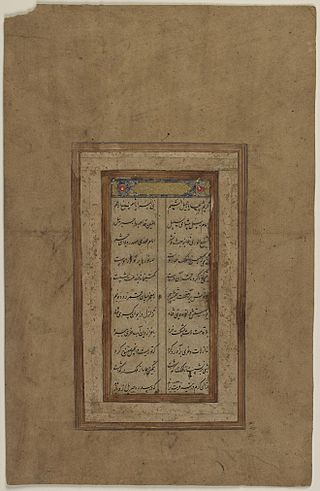
The Sidra tul-Muntaha in Islamic theology is a large lote tree or Sidr tree that marks the utmost boundary in the seventh heaven, where the knowledge of the angels ends. During the Isra and Mi'raj, Muhammad is said to have traveled with the angel Gabriel to the tree where Gabriel stopped while, beyond the tree, God instructed Muhammad about the five daily prayers.
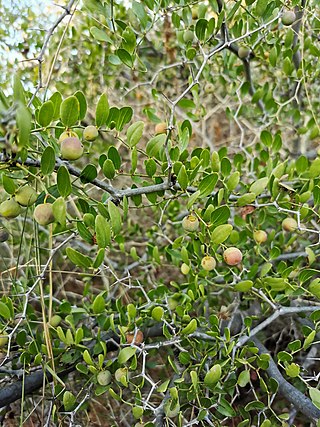
Ziziphus lotus is a small deciduous tree in the buckthorn family Rhamnaceae, native to the Mediterranean region, including the Sahara in Morocco and also Somalia. It is one of several species called "jujube", and is closely related to Z. jujuba, the true jujube.
Crown of thorns was worn by Jesus of Nazareth during the Passion.

Kil'ayim is the fourth tractate of Seder Zeraim of the Mishnah, dealing with several biblical prohibitions of mixed species, namely, planting certain mixtures of seeds, grafting different species of trees together, growing plants other than grapevines in vineyards, crossbreeding animals, working a team of different kinds of animals together, and mixing wool and linen in garments.

Paliurus spina-christi, commonly known as Jerusalem thorn, garland thorn, Christ's thorn, or crown of thorns, is a species of Paliurus native to the Mediterranean region, Southwest Asia and Central Asia, from Morocco and Spain east to Iran and Tajikistan.
Christ plant is a common name for several plants and may refer to:
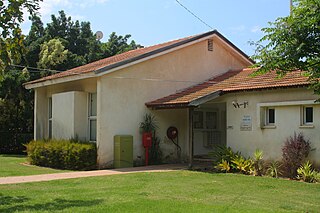
Bitan Aharon is a moshav in central Israel. Located in the Sharon plain between Hadera and Netanya, it falls under the jurisdiction of Hefer Valley Regional Council. In 2021 it had a population of 142.

Al-Na'ani, also called Al-Ni'ana, was a Palestinian Arab village in the Ramle Subdistrict of Mandatory Palestine. It was depopulated during the 1948 Arab–Israeli War on May 14, 1948, by the Givati Brigade during Operation Barak. It was located 6 km south of Ramle.

The Gulf of Oman desert and semi-desert is a coastal ecoregion on the Persian Gulf and the Gulf of Oman in Oman and the United Arab Emirates at the northeastern tip of the Arabian Peninsula. The climate is hot and dry, with gravelly plains and savanna with thorny acacia trees inland from the coast. Along the coast there are mixture of habitats that include mangrove swamps, lagoons and mudflats. The mangrove areas are dominated by Avicennia marina and the savanna by Prosopis cineraria and Vachellia tortilis. Masirah Island is an important breeding area for the loggerhead sea turtle and other sea turtles also occur here, as well as a great variety of birds, some resident and some migratory. There are some protected areas, but in general the habitats have been degraded by the grazing of livestock, especially camels and goats; they are also at risk from oil spills, off-road driving and poaching.
Kil'ayim are the prohibitions in Jewish law which proscribe the planting of certain mixtures of seeds, grafting, the mixing of plants in vineyards, the crossbreeding of animals, the formation of a team in which different kinds of animals work together, and the mixing of wool with linen in garments.
Demai is a Halakhic term meaning "doubtful". The demai status applies to agricultural produce acquired from common people who are suspected of not correctly separating tithes according to Jewish law. As a result, one who acquires demai produce must separate some of the tithes himself, in case this was not done earlier.
Spina is an Etruscan port city established by the end of the 6th century BCE on the Adriatic, Italy.
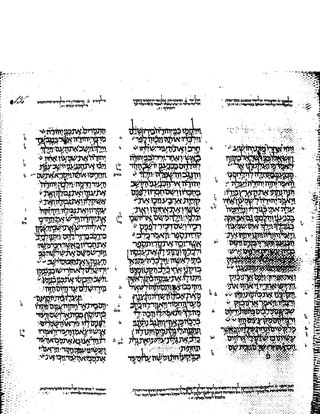
Judges 9 is the ninth chapter of the Book of Judges in the Old Testament or the Hebrew Bible. According to Jewish tradition the book was attributed to the prophet Samuel, but modern scholars view it as part of the Deuteronomistic History, which spans the books of Deuteronomy to 2 Kings, attributed to nationalistic and devotedly Yahwistic writers during the time of the reformer Judean king Josiah in 7th century BCE. This chapter records the activities of judge Gideon's son, Abimelech. belonging to a section comprising Judges 6 to 9 and a bigger section of Judges 6:1 to 16:31.
